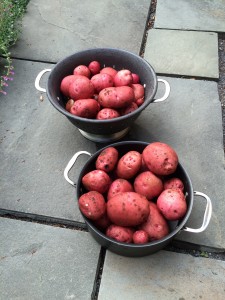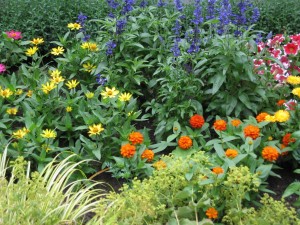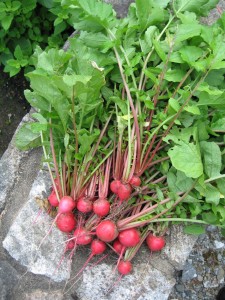When a Little Success Goes a Long Way
August 27, 2015 by admin
Filed under The Vegetable Patch
My first experiments in gardening decades ago were all with vegetables, so although I only plant and maintain vegetable gardens for a small number of clients these days (my work is really focused on ornamental gardening), I still enjoy growing a crop now and then. Every vegetable gardener knows that satisfying feeling of self-sufficiency that comes from producing something edible with your own two hands.
I grew up in the exurbs, and although I lived in a housing development, the lots were generous enough to accommodate large vegetable gardens for anyone who wanted to have one, and there were apple orchards, cornfields and pastures filled with grazing dairy cattle within walking distance. It’s kind of incredible to me how many people, especially city dwellers, have never had direct experience with raising their own food or even seeing it raised nearby.
Yesterday I showed a client how to dig potatoes. Her simple pleasure at unearthing something she would shortly enjoy for dinner was so earnest and elemental it reminded me why I started gardening in the first place.
This year I’ve had a couple of particularly satisfying vegetable garden successes that I’m going to share with you here and in at least one other upcoming blog post. First up, one of my favorite topics: choosing plants that offer the best chances of success, whatever your gardening goal.
My potato-growing client has had a bit of a roller coaster ride with vegetables, and it’s an educational one to hear about. Years ago, she started out wanting only flowers and herbs, but she slowly gravitated toward veggies because of that satisfaction factor I mentioned above. The shift from ornamentals to veggie crops raised a number of issues that I encounter again and again when trying to meet client expectations, so they’re worth examining:
She’s a part-time resident. I live in an area with a lot of second homes, and as it happens, all my clients are weekenders. Why is this a problem? The lack of a regular human presence on weekend properties makes them attractive to animals searching for a meal. Although living on a property day in, day out and year round is certainly no guarantee that you won’t have animals browsing your vegetable garden, in my experience weekend properties are more heavily browsed.
To me, this just makes sense. Animals aren’t stupid; if they find a good meal on a property and eat it undisturbed once, they’ll return. You would, too, if you were them. Once your garden is on an animal’s rounds, that habit is hard to break. So, right from the get go, this client’s garden is more vulnerable to animal browsing than those of year-round inhabitants.
What’s more, her occasional residency made it difficult to match crops to her schedule. Not everyone is a weekender, of course, but lots of people go on extended vacations in summer just when their gardens are starting to produce. Growing crops that will be ready when you are and buying the rest of your produce at the supermarket seems to me to be a better way to go. More on this below.
This garden is unfenced. One of the reasons for this is that the garden is at the front of the house. The space was never intended to be a vegetable garden, but rather an entry garden. Few people put their vegetable garden at the front of their house in part because a vegetable garden generally will need to be fenced to keep out browsing animals. While it’s possible to have an attractive yet functional fence, that’s an expensive prospect, and most people will opt for something more economical, such as unadorned chicken wire. That’s precisely no one’s idea of a beautiful sight, and some communities even have ordinances prohibiting this sort of treatment for a front “yard.”
You might be wondering why the vegetable garden is at the front of the house in the first place. Long story short, it’s because there is no other place where it can go, both on account of sun exposure (vegetable gardens require full sun) and also because of another sticky issue…
The builder left a mess behind buried in the soil. Sigh. This is a problem I encounter more often than not. It’s a common practice for builders to bulldoze construction debris into a pile, cover it with a thin scrim of soil, and then leave the problem for others to deal with. I’m not being snarky when I say this; it’s just a reality. It’s my impression, however, that most homeowners aren’t aware of this and are understandably surprised when they discover that the area where they want to put a garden is filled with stone, lumps of concrete, bricks, sawed-off 2x4s, nails, roofing shingles, or even broken glass. Obviously, remedying such a situation is a labor-intensive job, and that translates to high cost if you’re paying someone else to build your garden.
Even if your garden site is not filled with motley leftover building materials, if it’s adjacent to any sort of hardscaping (a walkway, stone patio or driveway, for example) it’s highly likely to be contaminated with “spillover” stone, stone dust and the like for a distance of up to several feet from the hardscaping itself.
This garden is no exception. It’s surrounded on all sides by some sort of stone: a gravel driveway, a stone wall, and drainage stone at the house foundation. Predictably, the garden is completely underlaid by stone that is not naturally occurring. I suspect the driveway was originally laid right up to the front door, and only later was a portion of it covered with about 8 inches of soil to look as if it were an entry garden just awaiting planting. Essentially, then, there is a driveway under the garden.
I could make a longer list, but the point of this post is not to indulge in a good rant. I’m just laying out the unvarnished problems that this particular property presents.
When I started this garden with just flowers and herbs, the problems enumerated above were not terribly limiting. There are many flowers and herbs that animals by and large don’t browse and are tolerant of shallow, lean, fast-draining soils. Nor did my client’s enjoyment of flowers and herbs depend on the timing of her visits.
Vegetables, however, were another matter entirely. Most want a rich, deep soil with moderate moisture-holding capacity, and of course, most are just as appetizing to animals as they are to us. What’s more, vegetables need to be harvested, and most need to be picked within a pretty narrow window of opportunity.
So I had a lot of conversations with my client (who was extremely patient and understanding throughout). Thankfully, she understood that adding a few vegetables to the mix in what would still be mostly a flower garden was an experiment, and that experiments often fail!
First, we went over which vegetables might actually be practical for her to have. I felt like a real Grinch telling her that a lot of the crops she was interested in wouldn’t be good choices for a weekender. Anything with a narrow harvest window had to be crossed off the list. You have about 48 hours of leeway with green beans, for example. Once they reach harvest size, they quickly become over-mature and inedible, and they don’t even have a particularly long shelf life in the refrigerator. They’re strictly a crop for a homeowner who is on her property every day and can harvest when the beans are ready and not a day too late. A fair number of other crops are like this.
Needless to say, any vegetable whose edible parts are borne above ground is especially susceptible to animal browsing, and the more tender and sweet the crop the more likely it is that an animal will give it a try.
Nonetheless, in the first couple of years having vegetables in her garden we had good success with cucumbers, radishes, zucchini, and even had a nice bunch of Cinderella pumpkins developing until they got sampled about a day before I was going to pick them. (Browsing animals have impeccable timing.) The cuke vines were raised off the ground in the hope that opportunistic browsers wouldn’t find them; almost no critter eats radishes except humans; I can’t explain the zucchinis except to speculate that the beasties had already filled up on them elsewhere and took a pass (even a woodchuck can reach zucchini overload); and I hoped the thick rinds of pumpkins would be offputting, which they were…up to a point. All in all, it worked pretty well.
Of course, I had to amend and deepen the soil, which I did with copious quantities of both topsoil and compost, but those are readily available, fairly inexpensive, and once added, don’t really have to be replaced. Soil problems are often the easiest gardening issues to remedy.
But there is a gardening axiom that eventually came into play. That axiom is: build it, and they will come. In other words, put food in your garden, and critters who previously found your property uninteresting will add it to their visiting rounds.
This applies just as well to insects and diseases as to rabbits, by the way, and not just to vegetables but also many ornamentals. Roses are a good example. I can’t tell you how many people have told me that they invested in a bunch of luscious David Austin roses and had a couple of seasons of great success with them before Japanese beetles, blackspot and other rose scourges became an annual occurrence. They’ll say with a deep sigh, “My roses have never been as good as those first couple of years.”
This is an incredibly common and completely predictable experience. The reason why the first few seasons went so well is that prior to planting the roses, these gardeners didn’t have anything in their gardens to attract Japanese beetles, blackspot, etc. It was the act of planting a suitable host for those organisms that attracted them to the property.
So, as you might expect, the first few years of having vegetables in this garden were relatively trouble free, and my client asked for more veggies and just a few flowers and herbs. But eventually, the local wildlife got the memo. Last year was an unmitigated disaster, with virtually everything getting mowed to the ground. Even the radish tops got browsed!
Fencing wasn’t really an option, not only because of unsightliness but because the dense packed stone underneath the garden made it impossible to sink fence posts without a herculean effort. We had to put this train in reverse.
This year, we returned to the flower/herb mix, and for good measure I planted only flowers with reputations for unpalatability: marigolds, dragon wing begonias, cannas, coleus, nicotiana, and the like. I wanted any browsing animal that came looking for dinner to get the message that this establishment had closed for business. But I hoped to give my client the satisfaction of at least one food crop, so I mentally inventoried all the possibilities and came up with…potatoes.
Why did potatoes fit the bill? One: The foliage of potato plants is virtually never browsed, so the lack of a fence didn’t matter. Two: They’re a root crop, and opportunistic browsers rarely dig for food. Three: Unlike most other root crops, the fundamental stoniness of her soil wasn’t a huge issue with potatoes. You mound soil up around potatoes as they grow, so you have a degree of flexibility with them that, say, carrots and beets don’t offer. Four: She’s only had potatoes in her garden one previous year, so there should not yet have been any build-up of potato diseases. Five: Her schedule didn’t really matter. Once the foliage on the plants died back (after which the potatoes will not continue to develop), the crop wouldn’t rapidly decline in quality but would wait patiently in the ground for her to be on hand to dig them. Six: She likes potatoes.
The results? Ten nice pounds of Chieftain spuds from four little pieces of seed potato (pictured way above). No, it’s not a cornucopia, but it’s something I was able to produce in a very small garden for a client who really wanted to grow a little bit of her own food, and I did it by carefully analyzing the problems at hand and picking what I thought was the best possible solution. I take this approach to everything I plant. It doesn’t always work, but it’s a heck of a lot better than the results I’d get by just planting a wish list and hoping for the best.
So, if you’ve got a less than ideal gardening situation, whatever the nature of the problems you face, my advice is to sit back and approach it rationally. (Who needs Lumosity when you can mentally spar with a woodchuck?) You can’t always get what you want, but if you try, you just might find you can get a little bit of what you need, and sometimes that’s the best you can do. Little successes are still…success!





